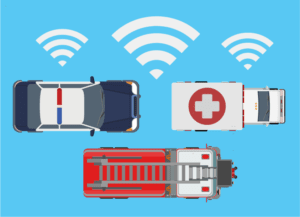 By striving for greater efficiency, safety and mobility, real-time telecommunication systems are being developed that can be installed in police cars and emergency vehicles. The progress made in terms of connectivity between vehicles and different infrastructures will surely bring many advantages to this sector.
By striving for greater efficiency, safety and mobility, real-time telecommunication systems are being developed that can be installed in police cars and emergency vehicles. The progress made in terms of connectivity between vehicles and different infrastructures will surely bring many advantages to this sector.
Many of the smart connections we use in our everyday lives have already been integrated in mobile environments such as buses or trains, and are now being tailored to emergency vehicles in order to optimize their operation and help improve the quality of life of citizens.
Some of the technological advances that have enabled us to equip these vehicles with such solutions are:
- The possibility of establishing a constant and reliable connection, thanks to different roadside-vehicle communication technologies (such as LTE, satellite, WiFi, WiMax, etc.) with the right speed and bandwidth. This way, coverage is guaranteed throughout the journey (even across forests, mountains, rural areas, the sea, etc.).
- The reliability of communications is guaranteed in all conditions: high speeds, constant movement, vibrations, sudden movements (such as braking and accelerating), different weather conditions, dampness, extreme temperatures, different types of terrain, etc.
- Safe communications, ensuring that unauthorized users do not gain access (thereby protecting the integrity of the data sent and received).
- WiFi in vehicles, to optimize the connection between on-board corporate devices and the vehicle’s surrounding area.
- Integration and interoperability between existing services (GPS, video, communications, etc.).
Thanks to the progress made in mobile technologies, real-time telecommunications can offer many advantages to police and emergency vehicles. Some of them are detailed below:
- Real-time access to data, which provides (among other things) access to patients’ medical records, police records or any other type of relevant report, from any location.
- The opportunity of arranging online consultations with other specialists, as well as the chance to make video calls.
- The improvement of fleet operations, allowing the different offices to learn the exact location of vehicles, the real-time traffic status, and the best routes to take to reach the incident location. This can give the hospital enough time to prepare for a patient’s arrival, or to decide which vehicle is best positioned to respond.
Plenty of solutions can be designed for this field, bringing in many of the advantages traditionally associated with the adoption of technologies linked to real-time communications. Thus, I am sure it is only a matter of time before we see more vehicles using this kind of system. At Teldat, we have extensive experience when it comes to developing devices that provide on-board telecommunications.

























